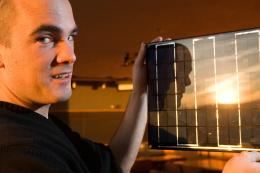Tobias Hanrath

Breaking down boundaries between academics and industry
Tobias Hanrath chose a path different from all the other engineers in his family. “As a chemical engineer, you have to make a choice,” says Hanrath. “Do you go into academics or do you go into industry? I am the first in my family to go into academics. At the end of the day I believe you have to go after what you really want to do—what the Germans call your ‘herzblut,’ or, heart’s blood.”
Hanrath, professor of chemical and biomolecular engineering at Cornell, focuses his research on understanding the fundamental relationships between the structure of nanomaterials and their resulting properties. “Where we are in the field of nanostructured materials today is a lot like where the field of polymers was 60 years ago,” says Hanrath. “On one level, it really is as simple as sticking particles together and seeing what properties emerge.” The Hanrath Energy Lab (HELios) aims to bring some order and structure to the study of these materials—they want to help figure out just what the rules are.
“These materials hold so much promise to play an enabling role in our transition towards sustainable energy technologies,” says Hanrath. “But before we get there, we need to build our understanding of how the basics of nanocrystal size, shape, composition, and surface chemistry affect the resulting electronic and optical properties of the materials we make.” So Hanrath works with professor Richard Robinson of Cornell’s Department of Materials Science and Engineering and professor Frank Wise of Cornell’s Department of Applied and Engineering Physics to build some of that basic understanding.
“Part of why I came to Cornell to begin with is the amount of collaboration across disciplines that happens here,” says Hanrath. “Maybe it is something positive that grows out of the isolation, but whatever the reason, interdisciplinary collaboration is in the DNA of Cornell Engineering.”
Quantum dots are tiny particles typically comprised of less than 10000 atoms, which leads to particle diameters in the range of 2-10 nanometers. Depending on the structure and composition of the individual dots, they can be combined in many possible configurations, (much like different colors and shapes of LEGO blocks can be combined to create larger structures.) In the case of nanocrystal-LEGOs, each configuration results in a material with different properties. Hanrath wants to use what he learns about how these molecular building blocks combine to then create materials that could greatly improve energy technologies, such as solar cells, solid-state lighting, or batteries. “One of our current projects explores nanostructured silicon. Silicon has already established a track-record as the key enabling material in the microelectronic revolution and the recent surge in solar cells; it now stands to revolutionize energy storage as well. You can store ten times more lithium in silicon than in the graphite used in batteries today; this is very exciting for next-generation high-capacity batteries, especially for electric vehicles,” says Hanrath.
Hanrath and business partner Charles Hamilton have started a company called Conamix to commercialize silicon nanowires that allow him to so dramatically improve energy storage capacity. With the help of the NEXUS-NY clean energy proof-of-concept center, Hanrath and Conamix are getting financial, educational, and business support to take their product from the lab to the market. “One of my goals is to have our lab cover the spectrum, from basic scientific discovery all the way to developing manufacturing processes,” says Hanrath. “We can take what we learn about the properties of nanostructured materials and use the knowledge to create actual products that can be put to use.”
When it is pointed out to Hanrath that it sounds as if he is stepping out of the purely academic sphere and beginning to join the rest of his family in industry, he smiles. But then he provides a compelling explanation. “So often in my academic papers I write about the possible applications of a discovery. Well, as engineers, we have an obligation to explore how we can translate that promise to practice, so it is important to check that we are right when we say in a paper ‘this material would be useful in batteries.’ We are finding out if this really is true.”
As if to counter the idea that he might be edging out of the academic world, Hanrath turns the conversation to talk of teaching. “One reason I came to Cornell in the first place,” says Hanrath, “is the quality of the students. They are simply above and beyond. I get to spend much of my day with bright, motivated, driven, and talented students in the classroom and in my lab. I really enjoy teaching.”
In fact, Hanrath is taking some of what he is learning about taking a product to market and he is incorporating it into his CHEME 4630 Practice of Chemical Engineering Product Design class. “Going through the process of determining just exactly where the value lies in our silicon nanowires makes teaching the product design class richer, deeper, and more valuable for me and for the students,” says Hanrath. Students in the class are given a general category of product and they spend a semester going through the entire product design process, from initial idea to final recommendation on the viability of their product.
When you combine the deep satisfaction Hanrath gets from his research with his obvious love of teaching, it is plain to see that Tobias Hanrath is a man who is following his herzblut.

